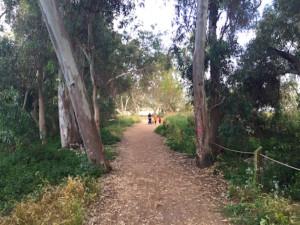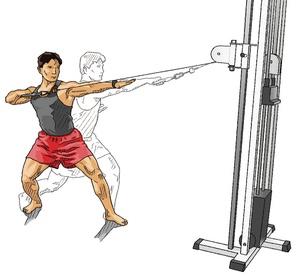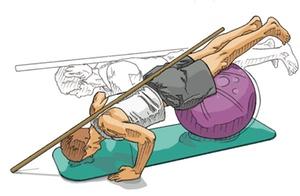Journey to Happiness With a Walk!
by Vidya McNeill

One of my favorite movement activities is to get outside and take a walk. There is something about the movement of my arms and legs swinging free, walking tall with my head up, breathing and pumping while being in nature that truly allows me to experience joyous delight.
As I walk, I reconnect with the quality of fresh ocean air, the gorgeous sight of nature around me, the splendorous sound of birds singing their hearts out, the warmth of the sun on my skin, and the changing morning or evening light in the sky. Going for a walk is a great way to give myself rejuvenating “me time,” encouraging my overall happiness and sense of wellbeing.
Walking is the balm for my soul.
 Walking is “movement as medicine” – body, mind and spirit.
Walking is “movement as medicine” – body, mind and spirit.
Today, our modern culture is characterized by “sitting disease.” It is reported that a sedentary lifestyle is the single strongest predictor of death, ahead of smoking and hypertension.
Many busy adults sit far too long at desks in front of computer screens working or relaxing in front of mobile devices or a TV. We see the results in posture-poor bodies whose heads fall forward, shoulders that are hunched and backs that become rounded.
Physically, prolonged sitting shortens the frontal muscles of the body and the deeper psoas major muscle, along with the scalenes at the neck, creating inflexibility and soft bones at all levels. Worse, sitting compresses the diaphragm where breathing deeply becomes compromised, strangling blood innervation to the organs and glands, and putting the person at risk for developing all sorts of diseases.
Without pumping the body, we have a difficult time removing waste from tissues or stimulating peristalsis action in the bowel. When the body becomes stagnant, so do our thoughts and moods. As Paul reminds us, “Movement is life!” Stop moving and we slowly die.
The connection of one’s physical health and brain health isn’t new. A recent study published in Gerontology looked at leg power, particularly the largest muscles of the body that are strengthened by standing and walking, and concluded that “meaty, muscular legs are linked to a similarly powerful mind,” especially later in life.
I noticed when my mother’s Alzheimer’s disease became more pronounced, she stopped moving. She became more depressed and anxious and had difficulty performing simple physical tasks like standing and walking as well as complex mental tasks.
Her muscles wasted away and became atrophied from disuse, especially her glutes, thighs and hamstrings. It was like watching her body become frozen. Eventually over a span of several years, her body began to fold into the fetal position.
Shockingly, many young adults and middle-aged people are so unfit they barely walk at all, except from their bed to a couch, car or chair. Unfortunately, our modern culture has given birth to a lazy generation.
Even younger people today have no leg power and sadly complain about walking a little way. One in four young adults walks for just five minutes each day.
Although we think of walking as an automatic process, it really isn’t. When you’re walking in the real world, it’s a complex action. CHEK practitioners are trained to assess and analyze gait mechanics.
Insights into normal walking patterns help CHEK practitioners work with clients to improve their gait-related pathologies and posture problems and expand all aspects of functional movement patterns, as well as increase their overall vitality and wellbeing.
Weight-bearing activities stimulate hip and lower-body bones to grow thicker, denser and stronger. When we walk, each step of the body’s movement is felt in its potential for freedom as we move with the earth’s gravitational pull.
When we navigate our way through the world, there are different pulls, constraints and freedoms that move us forward and empower a dream-affirmative life.
Walking is the easiest form of exercise to stay fit and reduce stress. On average, every minute of walking will extend the quality of your life experience.
As human beings, our bodies are designed for upright locomotion. Walking puts less strain on the lower back and creates less stress on joints such as the hips, knees and ankles.
Also, it helps us feel more grounded and balanced, while clearing the mind. Some of my most reflective and productive creative thinking happens when taking a walk.
Obviously, walking can be done almost anywhere and anytime. Walking with a friend, partner or child can help you build stronger relationships with them.
Since my time is valuable, I will often invite others to walk with me, so I can fulfill social needs and happily share my love of the natural beauty around me. I keep a pair of Vibram five-finger shoes in my car so that I can conveniently hit a trail.
Even a two-minute walking break from sitting can improve the function of disease-fighting and metabolism-boosting pumping. As little as 15 minutes of walking at a heart-pumping pace three times a week can help keep pounds off while supporting the body’s natural biological oscillation and parasympathetic rebound.
Adding more time — 30 minutes of walking — several days a week will change your life for the better.
I encourage you to go walk outdoors, even if you are conditioned to run or lift in the gym. Find some hill climbing to change up the angle and challenge yourself. Consistency is key.
As Hippocrates said, “Walking is man’s best medicine.” If you take a few minutes to stretch your hips, quads, hamstrings, calves and psoas before you begin, your body will thank you for it.
You’ll become more fit, inspired, stronger and happier as you journey to happiness with walking.
Reference:
Steves C, J, Mehta M, M, Jackson S, H, D, Spector T, D, Kicking Back Cognitive Ageing: Leg Power Predicts Cognitive Ageing after Ten Years in Older Female Twins. Gerontology, 2016;62:138-149.


